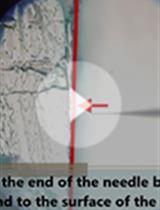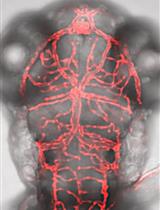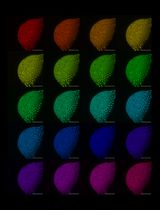- EN - English
- CN - 中文
Fluorescent PCR–based Screening Methods for Precise Knock-in of Small DNA Fragments and Point Mutations in Zebrafish
基于荧光PCR的斑马鱼DNA小片段精确敲除和点突变筛选方法
发布: 2023年08月05日第13卷第15期 DOI: 10.21769/BioProtoc.4732 浏览次数: 1316
评审: Alberto RissoneQin TangGülçin ÇAKAN AKDOĞAN
Abstract
Generation of zebrafish (Danio rerio) models with targeted insertion of epitope tags and point mutations is highly desirable for functional genomics and disease modeling studies. Currently, CRISPR/Cas9-mediated knock-in is the method of choice for insertion of exogeneous sequences by providing a repair template for homology-directed repair (HDR). A major hurdle in generating knock-in models is the labor and cost involved in screening of injected fish to identify the precise knock-in events due to low efficiency of the HDR pathway in zebrafish. Thus, we developed fluorescent PCR–based high-throughput screening methods for precise knock-in of epitope tags and point mutations in zebrafish. Here, we provide a step-by-step guide that describes selection of an active sgRNA near the intended knock-in site, design of single-stranded oligonucleotide (ssODN) templates for HDR, quick validation of somatic knock-in using injected embryos, and screening for germline transmission of precise knock-in events to establish stable lines. Our screening method relies on the size-based separation of all fragments in an amplicon by fluorescent PCR and capillary electrophoresis, thus providing a robust and cost-effective strategy. Although we present the use of this protocol for insertion of epitope tags and point mutations, it can be used for insertion of any small DNA fragments (e.g., LoxP sites, in-frame codons). Furthermore, the screening strategy described here can be used to screen for precise knock-in of small DNA sequences in any model system, as PCR amplification of the target region is its only requirement.
Key features
• This protocol expands the use of fluorescent PCR and CRISPR-STAT for screening of precise knock-in of small insertions and point mutations in zebrafish.
• Allows validation of selected sgRNA and HDR template within two weeks by somatic knock-in screening.
• Allows robust screening of point mutations by combining restriction digest with CRISPR-STAT.
Graphical overview

Overview of the three-phase knock-in pipeline in zebrafish (created with BioRender.com)
Background
The use of zebrafish for functional genomics and disease modeling has gained popularity in recent years due to the availability of CRISPR/Cas9-based methods for generating desired gene knockout and knock-in models. These methods are based on the introduction of a double-strand break (DSB) at a desired site in the genome by CRISPR/Cas9 followed by non-homologous end joining (NHEJ)-mediated indels causing gene knockouts or homology-directed repair (HDR)-mediated knock-in of exogenous sequences by providing a donor DNA template. Several studies have shown that single-stranded oligonucleotides (ssODNs) with asymmetric homology arms based on Richardson et al., (2016) can be used to generate fish with targeted knock-in of in-frame epitope tags for proteomics analysis, LoxP sites for conditional knockout, and stop codons or patient-specific point mutations for in vivo disease modeling (Burg et al., 2018; Prykhozhij et al., 2018; de Vrieze et al., 2021; Sieliwonczyk et al., 2023). However, this is a challenging process due to the low efficiency of HDR in zebrafish, requiring extensive founder screening by either labor-intensive gel-based methods—such as allele-specific PCR and restriction fragment length polymorphism, cloning, and sequencing—or highly sophisticated computational analysis of next generation sequencing data (Bedell et al., 2012; Armstrong et al., 2016; Prykhozhij et al., 2018; Zhang et al., 2018; de Vrieze et al., 2021; Sieliwonczyk et al., 2023). Thus, easy, scalable, and robust screening methods are required to identify the rare precise knock-in events from the common NHEJ-mediated indels or recombination errors.
Here, we describe our recently demonstrated fluorescent PCR–based screening methods for successful generation of zebrafish knock-in models with epitope tags, point mutations, or any other small insertions using ssODNs (Carrington et al., 2022). Fluorescent PCR is highly sensitive and allows accurate sizing of all fragments in a PCR product even from mosaic samples using CRISPR-STAT (Carrington et al., 2015). For insertion of epitope tags or any other sequences of known size, we can distinguish knock-in alleles from the wildtype (WT) or CRISPR/Cas9-induced random indels by size of the expected peak. For knock-in of point mutations, we combined fluorescent PCR with a restriction digest so that exact sizes of digested products with or without the knock-in can be determined. The restriction site can be introduced in the repair template by the desired point mutation, change of the PAM site, or a silent change. Our screening method cannot be used if the same restriction site is also present in the amplicon upstream of the intended point mutation, or a restriction site cannot be introduced by the above methods. Overall, our screening methods allow the user to determine within a week if knock-in is occurring in injected embryos or if the design of sgRNA/repair template needs to be reevaluated. Our methods are easy to implement as many zebrafish researchers are already using fluorescent PCR for genotyping and CRISPR-STAT for sgRNA evaluations (Varshney et al., 2016; Ramanagoudr-Bhojappa et al., 2018; Hoshijima et al., 2019; Pillay et al., 2022). This method can also be adopted by researchers using other model systems, as it is a PCR-based screening method.
Materials and reagents
Biological materials
Zebrafish (Danio rerio): zebrafish strains can be obtained from collaborators or repositories, such as the Zebrafish International Resource Center (https://zebrafish.org/home/guide.php) or the European Zebrafish Resource Center (https://www.ezrc.kit.edu/).
General reagents
Instant ocean aquarium salt (Petco, catalog number: 77763)
Reverse osmosis water
TE, pH 8.0 (Quality Biological, catalog number: 351-011-131)
Ultrapure water (KD medical, catalog number: RGF-3410)
Project-specific restriction enzymes and associated buffers (New England Biolabs)
Primers and HDR template
M13F-FAM Primer-/56-FAM/TGTAAAACGACGGCCAGT (IDT)
Note: Primer should be resuspended to 100 μM using TE, pH 8.0.
Project-specific primers for fluorescent PCR designed as described in section A1, step 2: forward M13F tailed primer and reverse PIG-tailed primer (IDT)
Note: Primers should be resuspended to 100 μM using TE, pH 8.0.
Project-specific primers for fluorescent knock-in screening designed as described in section A4, step 2: knock-in screening forward M13F tailed primer and knock-in screening reverse PIG-tailed primer (IDT)
Note: Primers should be resuspended to 100 μM using TE, pH 8.0.
Project-specific top strand oligos (IDT) designed as described in section A1, step 1c.
Note: Top strand oligos should be resuspended to 100 μM using TE, pH 8.0. After resuspension, store indefinitely at -20 °C.
Universal bottom strand ultramer (5′-AAAAGCACCGACTCGGTGCCACTTTTTCAAGTTGATAACGGACTAGC CTTATTTTAACTTGCTATTTCTAGCTCTAAAAC-3′) (IDT)
Critical: Aliquots should not go through multiple freeze-thaw cycles. Resuspension in water is not recommended.
Note: Bottom strand ultramer should be resuspended to 100 μM using TE, pH 8.0. After resuspension, store indefinitely in 10–15 μL aliquots at -80 °C.
Project-specific HDR templates ordered as ultramers (IDT) or ssDNA (Azenta Life Sciences)
sgRNA and Cas9 synthesis reagents
Phusion High Fidelity DNA Polymerase and associated 5× buffer (NEB, catalog number: M0530S)
Advantage UltraPure PCR dNTP mix (10 mM each) (Takara, catalog number: 639125)
HiScribe T7 Quick High Yield RNA Synthesis kit (NEB, catalog number: E2050S)
RNA Clean and Concentrator-5 kit (Zymo Research, catalog number: R1016) Critical: Other RNA purification kits may not work as well due to the small size of the RNA being purified.
Ethyl alcohol, pure (EtOH) (Sigma, catalog number: 459844)
pT3TS-nls-zCas9-nls plasmid (Addgene, catalog number: 46757)
XbaI and CutSmart buffer (New England Biolabs, catalog number: R0145S)
QIAquick PCR Purification kit (Qiagen, catalog number: 28104)
mMessage mMachine T3 Transcription kit (Thermo Fisher, catalog number: AM1348)
Gel electrophoresis reagents
Note: Equivalent reagents can be used as substitutes.
GeneRuler 50 bp DNA ladder (Thermo Fisher, catalog number: SM0371)
GeneRuler 1 kb DNA ladder (Thermo Fisher, catalog number: SM0311)
5× DNA gel loading solution (Quality Biological, catalog number: 351-028-661)
10× TAE buffer (Quality Biological, catalog number: 351-009-131)
UltraPure agarose (Thermo Fisher, catalog number: 16500500)
UltraPure ethidium bromide (Thermo Fisher, catalog number: 15585-011)
Caution: Carcinogenic. Wear gloves when handling.
DNA extraction reagents
Extraction solution (Sigma, catalog number: E7526)
Tissue preparation solution (Sigma, catalog number: T3073)
Neutralization solution B (Sigma, catalog number: N3910)
PCR reagents
AmpliTaq Gold DNA Polymerase with Gold Buffer and MgCl2 (Thermo Fisher, catalog number: 4311820)
GeneAmp dNTP blend (100 mM) (Thermo Fisher, catalog number: N8080261)
Capillary electrophoresis reagents
GeneScan 400HD ROX dye size standard (Thermo Fisher, catalog number: 402985)
Hi-Di formamide (Thermo Fisher, catalog number: 4440753)
Caution: Carcinogenic and target organ and reproductive toxicity. Wear gloves when handling.
Note: Store at -20 °C until ready to use. Avoid freeze thawing. Once thawed, store at 4 °C and use contents within four weeks.
POP-7 polymer for 3730/3730xl DNA Analyzer (Thermo Fisher, catalog number: 4335615)
Note: Store at 4 °C. Do not freeze.
3730 running buffer (10×) (Thermo Fisher, catalog number: 4335613)
Note: Cheaper alternative from VWR (catalog number: 97063-502) also works well.
TOPO cloning and sequencing reagents
MinElute Reaction Cleanup kit (Qiagen, catalog number: 28204)
TOPO TA Cloning kit for Sequencing, with One Shot TOP10 Electrocomp E. Coli (Thermo Fisher, catalog number: K458001)
LB agar plates with 100 μg/mL ampicillin (Thermo Fisher, catalog number: J63197)
Note: These can be prepared in-house using standard techniques.
ExoSAP-IT PCR Product Cleanup (Thermo Fisher, catalog number: 78201)
BigDye Terminator v3.1 Cycle Sequencing kit (Thermo Fisher, catalog number: 4337455)
DyeEx 96 kit (Qiagen, catalog number: 63183)
Solutions
Egg water (see Recipes)
Fluorescent PCR primer mix (see Recipes)
Fluorescent PCR master mix (see Recipes)
Recipes
Egg water
Reagent Final concentration Amount Instant ocean aquarium salt n/a 1.92 g Reverse osmosis water n/a 32 L Total n/a 32 L Store solution at room temperature (RT) for up to six months.
Fluorescent PCR primer mix
Reagent Final concentration Amount TE, pH 8.0 n/a 485 μL Forward M13F tailed primer (100 μM) 1 μM 5 μL Reverse PIG-tailed primer (100 μM) 1 μM 5 μL M13F-FAM primer (100 μM) 1 μM 5 μL Total n/a 500 μL Store primer mix at 4 °C in a covered box to avoid exposure to light.
Fluorescent knock-in screening primer mix
Reagent Final concentration Amount TE, pH 8.0 n/a 485 μL Knock-in screening forward M13F tailed primer (100 μM) 1 μM 5 μL Knock-in screening reverse PIG-tailed primer (100 μM) 1 μM 5 μL M13F-FAM primer (100 μM) 1 μM 5 μL Total n/a 500 μL Store primer mix at 4 °C in a covered box to avoid exposure to light.
Fluorescent PCR master mix
Reagent Final concentration Amount 10× Gold Buffer 1.5× 7.94 mL 25 mM MgCl2 solution 3.97 mM 7.94 mL GeneAmp 100 mM dNTP blend 1.59 mM 795 μL AmpliTaq Gold DNA Polymerase 1.25 U 635 μL Ultrapure water n/a 32.69 mL Total n/a 50 mL Gold Buffer and MgCl2 come with the AmpliTaq Gold DNA Polymerase. Aliquot PCR master mix into 500 μL and 1 mL aliquots and store indefinitely at -20 °C.
Laboratory supplies
Note: Any equivalent supplies can be used.
Microcentrifuge tubes, 1.7 mL (VWR, GeneMate, catalog number: 490003-230)
Pipettes [Rainin, catalog numbers: 17014393 (0.1–2 μL), 17014388 (0.5–10 μL), 17014392 (2–20 μL), 17014391 (20–200 μL), 17014382 (100–1,000 μL), 17013808 (2–20 μL multichannel)]
Needle loading tips (Eppendorf, catalog number: 930001007)
Glass capillaries (World Precision Instruments, catalog number: TW100F-4)
96-well PCR plates (SSIbio, catalog number: 3400-00)
Plate seals (Azenta, catalog number: 4ti00500)
96-well semi-skirted plates for 3730xl DNA analyzer (SSIbio, catalog number: 3450-00)
Equipment
Note: Any equivalent device can be used.
Microcentrifuge (MidSci, catalog number: C2400)
Vortex (Diagger, catalog number: SI-0236)
Block heater at 37 °C (Thermo Fisher, catalog number: 13687720)
Owl D2 wide-gel electrophoresis system (Thermo Fisher, catalog number: D2)
NanoDrop spectrophotometer 1000 (Thermo Fisher)
PCR plate spinner (VWR, catalog number: 89184-608)
Veriti 96-well thermal cycler 0.2 mL (Thermo Fisher, catalog number: 4479071)
Microinjection apparatus (World Precision Instruments)
Needle puller (Kopf Instruments model 710)
-20 °C freezer (VWR, catalog number: 10819-850)
-80 °C freezer (Thermo Fisher, catalog number: TSX40086A)
3730xl DNA Analyzer equipped with a 36 cm capillary (Thermo Fisher, catalog number: A41046)
Incubator at 28.5 °C (Thermo Fisher, catalog number: 51028068)
Incubator at 37 °C (Thermo Fisher, catalog number: 50125590)
Software and datasets
UCSC genome browser (Zebrafish Assembly GRCz11/danRer11) https://genome.ucsc.edu/cgi-bin/hgGateway
Sequencher version 5.3 (Gene Codes)
Note: Any equivalent sequence analysis software can be used.
3730xl Data Collection Software 5 (Thermo Fisher).
Note: CRISPR-STAT module settings can be found in Varshney et al. (2016).
GeneMapper Software version 6 (Thermo Fisher, catalog number: 4475073)
Note: Panel manager and analysis method editor settings can be found in Varshney et al. (2016).
Procedure
文章信息
版权信息
© 2023 The Author(s); This is an open access article under the CC BY-NC license (https://creativecommons.org/licenses/by-nc/4.0/).
如何引用
Carrington, B. and Sood, R. (2023). Fluorescent PCR–based Screening Methods for Precise Knock-in of Small DNA Fragments and Point Mutations in Zebrafish. Bio-protocol 13(15): e4732. DOI: 10.21769/BioProtoc.4732.
分类
发育生物学 > 基因组编辑 > 靶向整合
分子生物学 > DNA > 诱/突变
您对这篇实验方法有问题吗?
在此处发布您的问题,我们将邀请本文作者来回答。同时,我们会将您的问题发布到Bio-protocol Exchange,以便寻求社区成员的帮助。
提问指南
+ 问题描述
写下详细的问题描述,包括所有有助于他人回答您问题的信息(例如实验过程、条件和相关图像等)。
Share
Bluesky
X
Copy link












